|
Mithila
Brahmans
Mithila Casts
Darbhanga Raj
Maithili
Language
Maithili is an Indo-Aryan language that
is spoken by the people of North- Eastern Bihar and Nepal. The
language has been named Maithili because it is spoken in the ancient
land of Mithila. It is also called Tirhutia because Tirhut is
another name of the same region, which is derived from Tirabhukti,
which means the bank of the river purified thrice by the sacrifices.
An Italian scholar named Amaduzzi in his book Alphabetum
Brahmmanicum (1771A.D.) has mentioned this language as Maitili.
At present, the language has about 30 million speakers in the 26
districts of N.E. Bihar. Moreover it is the second state language of
Nepal. The language is spoken by 12% of the total population there.
P.E.N (an international organization of letters for Poets,
Essayists, Novelists) and the Sahitya Akademi, India have recognized
Maithili.
It is the sixteenth most spoken languages in India and the fortieth
most spoken languages of the world. It has its own script called the
Mithilakshar or Tirhuta, originated from Brahmi, a script of 3 BC
also found in Asokan Inscriptions. Present day Maithili writers and
public at large have adopted Devanagari script because of its
widespread use, popularity and convenience.
Scholars believe that Siddhacharyas formed Protomaithili during
8-9th c. A.D. when they composed Charyapada (vide Prof.
R.K.Chaudhary'sThe Survey of Maithili Literature ) since then the
language has progressed and several works have been found. The forms
of Protomaithili words are also obtained sporadically in Prakrit
Paingalam and other Sanskrit works written by scholars of Mithila
under the native influence. In 14th c AD Kavi Shekhar Jotirishwar
used the language Avahatta, a form of Protomaithili in his
Varnaratnakar, which depicts the oldest prose used for the first
time in any of the languages of Northeastern India. Vidyapati the
most prolific writer has also used Avahatta, form of Proto Maithili,
in his dramas, the Kirtilata and Kirtipataka. He also composed
melodious poems depicting the love of Radha-Krishna in his Padavali
that is written in the Maithili of medieval period. Vidyapati also
influenced Nepali, Bengali, Assamese, Oriya and Manipuri literature
during the medieval period. His influence has also been seen unto
the modern period in the Shyama Sangeet of Rabindranath Thakur
,composed by pen name as Bhanu Singher Padavali.
Maithili also flourished in the court of Kings of Nepal, during
Malla period. Several dramas, anthologies of lyrical poems, songs,
and inscriptions in Maithili are available in Nepal of this period
In Assam, Ankiya natak's dialogue and songs used to be composed in
Maithili in the period of Shankardev and Madhavdev.
During the last 150 years the foreign scholars like Colebrooke
(1801), Hoernle (1880), Grierson (1881), Kellog (1893) and others
have studied Maithili's grammar, phonology, lexicography, historical
surveys, and comparative linguistics. These scholars along with
Indian linguists like Dr. Suniti Kumar Chatterji and Mahapundit
Rahul Sankrityayan have declared Maithili as a full fledged
independent language which has originated from Sanskrit-Prakrit,
Magadhi-Prakrit, Apabhramsa, to Avahatta, Protomaithili and then
developed into the formation of modern Maithili. Earlier attempts
were made by Sir G.A Grierson to publish the grammar in 1881 AD,
chrestomathy and vocabulary of the language in 1882 AD and Bihar
peasant life in 1885 AD to compile the form of Maithili words. He
also collaborated with Hoernle to write a comparative dictionary of
the Bihari languages in 1885 & 1889 AD
. In 1946, Pundit Deenbandhu Jha wrote its grammar based on the
sutras of Sanskrit grammar of Panini. He also published a Maithili
Dictionary in 1950. In 1973 the Institute of Advanced Studies Simla,
published an incomplete dictionary of the language compiled by Dr.
Jayakant Mishra. Now, Royal Nepal Academy has taken up the job to
publish a Maithili - Nepali - English Dictionary under the guidance
of Dr. Y. Yadav. Dr. Subhadra Jha has written the formation of
Maithili language in 1958. Prof. Radhakrishna Choudhary has written
the Survey of Maithili Literature (1964), Dr. Jayakant Mishra has
written the History of Maithili Literature. In 1968 Pt. Govind Jha
wrote The Origin and Growth of Maithili and he has also compiled a
Maithili - English dictionary recently.
In modern times various writers regularly produce literary writings
in all genres like poetry, prose, essays plays, dramas, fiction,
critical reviews, epics etc. depicting the culture, history,
journalism, and linguistics. Moreover Maithili has an enormous stock
of oral literature in the form of folk tales in prose, verse,
ballads and songs.
In spite of all this though even minor languages have been included
in the 8th schedule of the Indian constitution, Maithili has been
ignored its rightful entry there. It is the perception of the
speakers of this language, that due to political connivance, the
language in its native state Bihar, has been given the minority
status, despite the fact that almost half the population speaks
Maithili. Hindi zealots time and again claim that the language is a
dialect of Hindi having no independent entity despite strong
evidence to its contrary. It is a well-known fact that the history
of Maithili literature is more than a millennium years old whereas
that of Hindi literature has a history of barely 200 years since
Bhartendu Harishchandra.
Unfortunately Maithili speakers themselves don't take pride in the
common daily use of the language. No dailies are published. Even
periodicals and magazines are published few and far between. The
language bears the insult of Hindi zealots and the apathetic state
government. Institutions are taken lightly. The language has been
derecognised by the state government from the educational curriculum
and the state civil service examinations. The candidates have to
choose, under pressure a language other than their mother tongue
with which they are not well conversant for this examination.
To a great extent Maithili speakers are themselves to be blamed
because of lack of unity among themselves, too much consideration of
caste, creed, religion, regionalism, parochialism and the vast gap
between the elitists and the downtrodden.
It should not be forgotten that Maithili belongs as much to dalits,
Muslims, and people belonging to lower caste as much as it belongs
to persons of upper castes. The ballads and other folk tales like
Lorik, Nayaka Banjara, Salhes, Deenabhadri, Rayaranpaal, etc. have
been preserved by these so-called dalits and lower castes since the
time immemorial by memorizing and singing traditionally. These are
as important contribution to the Maithili literature as are the
writings of upper caste.
|
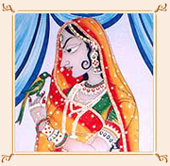
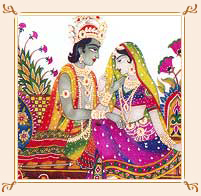
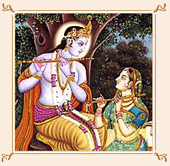
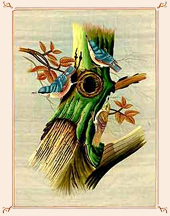
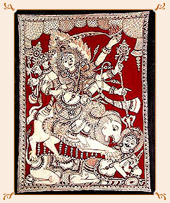
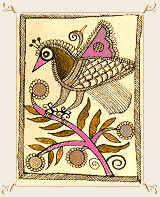
|
